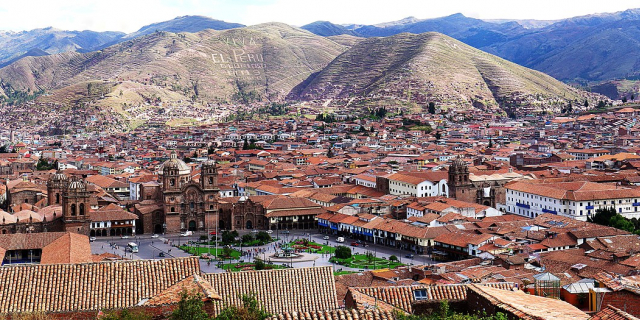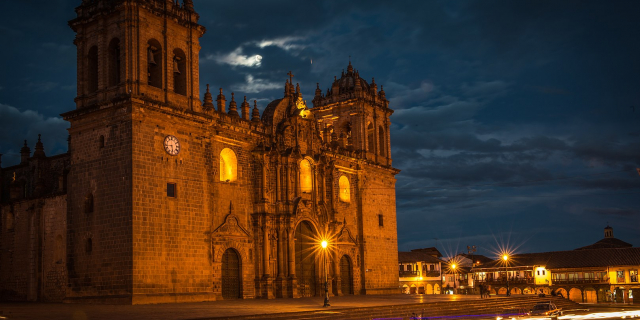Tipón
Tipón, is a sprawling early fifteenth-century Inca archaeological park that is situated between 3,250 metres (10,660 ft) and 3,960 metres (12,990 ft) above sea level, located 22 kilometres (14 mi) southeast of Cusco near the village of Tipón. It consists of several ruins enclosed by a powerful defensive wall about 6 kilometres (3.7 mi) long. The most renown (and easily accessible) part of the park is the group of precise and right angled monumental terraces irrigated by a network of water canals fed by a monumental fountain channeling water from a natural spring. The site includes ancient residential areas and a remarkable amount of petroglyphs in its upper part.
The irrigation system based on canals, fountains and stonework with water drop structures shows that the Incas had an advanced water related technology and were experienced hydraulic engineers.
Since 1970's the area has been excavated and restored. Works are still ongoing (2021).
Most probably th...Read more
Tipón, is a sprawling early fifteenth-century Inca archaeological park that is situated between 3,250 metres (10,660 ft) and 3,960 metres (12,990 ft) above sea level, located 22 kilometres (14 mi) southeast of Cusco near the village of Tipón. It consists of several ruins enclosed by a powerful defensive wall about 6 kilometres (3.7 mi) long. The most renown (and easily accessible) part of the park is the group of precise and right angled monumental terraces irrigated by a network of water canals fed by a monumental fountain channeling water from a natural spring. The site includes ancient residential areas and a remarkable amount of petroglyphs in its upper part.
The irrigation system based on canals, fountains and stonework with water drop structures shows that the Incas had an advanced water related technology and were experienced hydraulic engineers.
Since 1970's the area has been excavated and restored. Works are still ongoing (2021).
Most probably the Tipón complex was an imperial Inca estate or at least a sort of feudal estate for Inca elite built in the time of Pachacuti or his son, Topa Inca Yupanqui and it is supposed that also ceremonial activities took place in it. The site may have also been used as a laboratory for agricultural products because of the various micro-climates found within the complex, a reliable round-the-year water supply and the fertile soil.
Tipón is considered one of the most important archaeological tours for tourists who visit the Cusco area.
 Tipón - view of retaining walls with stepping stones
Tipón - view of retaining walls with stepping stonesThe reports of the archaeological works conclude that the site was continuously occupied from the Formative stage, by the Marcavalle culture, around 1000 BCE, through the Chanapata (800 BCE), Qotakalli (700 CE), Huari (700 CE to 1200 CE) and Killke (900 to 1200 CE), until the Inca period (13th century to 1572). The artifacts found on site show that Tipón was an important ceremonial, administrative and religious center during Inca times. The Cruzmoqo hill, on top of the Tipón complex, is supposed to have been a very important signal point, communications and observation station along the road to the Vilcanota/Urubamba Sacred Valley.[1] Tipón (whose original name was Muyna or Moyna) was, a very important settlement of the pre-Inca tribe of the Pinagua, finally becoming an Inca llaqta (administrative settlement). The Pinaguas may have been part of the Ayarmaca kingdom whose uprising against the Inca rule is known to have occurred during the reigns of Inca Roca and Viracocha Inca, having been definitively subdued by Pachacuti, in the middle of the 15th century.[2]
According to the historian Víctor Angles Vargas[3] interpreting a passage from the chronicle of the Comentarios Reales de los Incas[4] by Garcilaso de la Vega, Tipón was built by Viracocha Inca as a residence and refuge for his father Yawar Waqaq, who was overthrown for escaping during a rebellion of the Chankas. Garcilaso mentions that, by mutual agreement, in order to avoid a civil war, father and son «...drew up a royal house, between the narrow area of Muyna and Quespicancha, in a pleasant place … with all the gifts and delights that could be imagined». Nevertheless, subsequent studies and later interpretations have made it clear that it was the elder Viracocha who fled before the arrival of the Chankas, not to this place but to the Sacred Valley while confirming a close relationship of Yawar Waqaq with the Tipón site.[5]
The name Tipón appears for the first time in the will of Doña Tomasina de la Vega, one of the first owners of the Quispicanchi estate in the 16th century and widow of a Don Griego, mentioning the «lands of Tipón and Guaypar» and of «some lands within old enclosures».[1]

































Add new comment